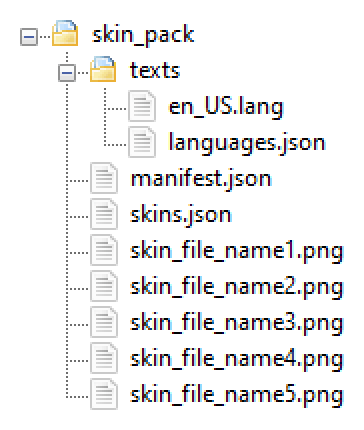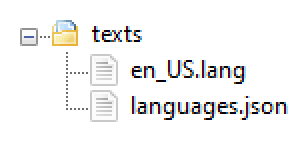Packaging a Skin Pack
Skin packs are some of the most popular content available, offering players multiple looks for their avatars and fundamentally changing the feel of their gameplay experience. Creating a skin pack is not only a great way to offer something new to players, it's also a lot of fun both technically and artistically!
In this guide you will learn:
- The folder and file structure for skin packs in Minecraft: Bedrock Edition.
- How to construct the necessary metadata files for a skin pack and how to define skins using them.
Skin Pack Folder Structure

manifest.json
A manifest tells Minecraft general information about your skin pack. Create a JSON file named manifest.json at the root of the skin pack. Within it contains the following:
name: the name of the pack, which is alwayspack.name.version: the version of the pack. For example,[1, 0 ,0]would indicate version 1.0.0.uuid: a unique identifier to prevent package conflicts, which can be generated from this site: https://www.uuidgenerator.net/version4 (two different UUIDs need to be generated).type: set toskin_packto tell the game to treat this pack as a skin pack.
Template manifest.json
{
"header": {
"name": "pack.name",
"version": [1, 0, 0],
"uuid": "<FIRST GENERATED UUID>"
},
"modules": [
{
"version": [1, 0, 0],
"type": "skin_pack",
"uuid": "<SECOND GENERATED UUID>"
}
],
"format_version": 1
}
skins.json
A skins.json file will define the skins that come with your skin pack. Create a JSON file named skins.json at the root of the skin pack. Within it contains the following:
localization_nameandserialize_name: these will be the same and are the localization keys whose value will be defined later inen_US.langwith the full key beingskinpack.<localization_name>. That value will be the title of the pack. The key will also always be prepended to each individual skin's localization key.skins: a collection of definitions, each defining a single skin.
Each individual skin definition will then contain the following:
localization_name: the localization key whose value is defined later inen_US.lang. The value will be the name of the individual skin.geometry: the base model this skin is for.geometry.humanoid.customSlimis the Alex model andgeometry.humanoid.customis the Steve model.texture: the file name for each of the skin textures as they appear in the root of the skin pack.type: eitherfreeorpaid.
Template skins.json
Note
Unfortunately, it's not possible to add custom models to skin packs at this time using the skin pack JSON capability.
{
"serialize_name": "TemplateSkinPack",
"localization_name": "TemplateSkinPack",
"skins": [
{
"localization_name": "TemplateSkin1",
"geometry": "geometry.humanoid.customSlim",
"texture": "skin_file_name1.png",
"type": "free"
},
{
"localization_name": "TemplateSkin2",
"geometry": "geometry.humanoid.custom",
"texture": "skin_file_name2.png",
"type": "free"
},
{
"localization_name": "TemplateSkin3",
"geometry": "geometry.humanoid.customSlim",
"texture": "skin_file_name3.png",
"type": "paid"
},
{
"localization_name": "TemplateSkin4",
"geometry": "geometry.humanoid.custom",
"texture": "skin_file_name4.png",
"type": "paid"
},
{
"localization_name": "TemplateSkin5",
"geometry": "geometry.humanoid.custom",
"texture": "skin_file_name5.png",
"type": "paid"
}
]
}
Skin Textures
The actual skin textures are PNGs. The file names are referred to in the skins.json metadata file. They can be used only at the root of the skin pack. You can use Blockbench to create a usable skin PNG for your skin pack.
Texts Folder
Inside this folder are the en_US.lang and languages.json files, which define the actual names of your pack and skins and the supported languages of your pack. The names after the = are what show up in-game, such as in the skin picker.

en_US.lang
This is the file where you name your pack and the skins.
- Pack name:
skinpack.[skins.json localization_name]=[name of pack] - Skin names:
skin.[skins.json localization_name].[skins.json single skin localization_name]=[name of skin]
The below template uses the "localization keys" from the template skin.json to name the pack "Your Skin Pack Name Here" and to name the individual skins "Skin Name 1-5".
Template en_US.lang
skinpack.TemplateSkinPack=Your Skin Pack Name Here
skin.TemplateSkinPack.TemplateSkin1=Skin Name 1
skin.TemplateSkinPack.TemplateSkin2=Skin Name 2
skin.TemplateSkinPack.TemplateSkin3=Skin Name 3
skin.TemplateSkinPack.TemplateSkin4=Skin Name 4
skin.TemplateSkinPack.TemplateSkin5=Skin Name 5
Feedback
Coming soon: Throughout 2024 we will be phasing out GitHub Issues as the feedback mechanism for content and replacing it with a new feedback system. For more information see: https://aka.ms/ContentUserFeedback.
Submit and view feedback for